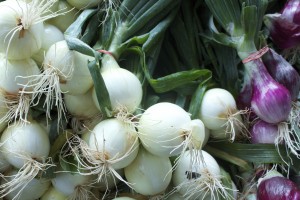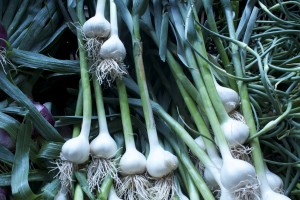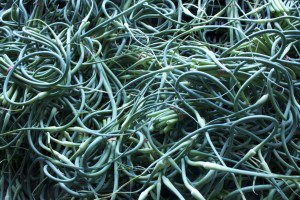
|
The Onion Family The onion, or lily family, is characterized by strong tastes and sulfurous odors, and includes onions, leeks, scallions, garlic, chives, and shallots. Known as alliums, these universally used vegetables have abundant health benefits. They are antioxidants, anti-inflammatory, antibiotic, and antiviral. They help remove parasites and heavy metals from the body. They contain Vitamin A, B-Complex, and C. How the alliums are cooked influences how pungent they are. Garlic cooked whole is only sightly pungent, and sweet nutty notes come to the front. If onions and garlic are pickled, they are relatively mild. Long, slow cooked onions become sweet. The sulfur product, which causes our eyes to water, is produced in significant quantities only in the onions, shallot, leek, and chive, most especially in onions. To avoid crying, you can pre-chill an onion for 30 to 60 minutes in ice water. It hydrates the papery onion skin, which makes it tougher and less brittle, and easier to peel off. Chopped alliums to be eaten raw are best rinsed to remove irritating strong smelling sulfurous molecules. Soak a sliced raw red onion in cold water for fifteen minutes, for example, before adding to your salad. Here are some things to know about some of the most common varieties in the lily family. Onions fall into two major categories: Spring onions are planted as seedings in the late fall and harvested before maturity following the spring and early summer. You see them in green markets with the green shoots coming out of them. They do not have brown papery skin hiding the bulbs. They are moist, relatively mild, and perishable; and are best kept in the refrigerator. The second category is the globe storage onion, the most common type, available all year. They are grown in the summer and harvested when mature in the fall, and are rich in sulfur compounds. Look for firm onions with papery dry skin, not beginning to sprout. These are best stored in a dry, well ventilated place, not near potatoes, and not refrigerated. White onions are milder and moister than yellow, and don’t keep as well. Small and medium onions are more pungent than large, which are sweeter. Red onions are also sweeter and milder than the globe, are favored in pickles and condiments, and store for two to four weeks. When red onions are cooked, the color is diluted. A little acid, like lemon or vinegar, brings the color back.
Scallions can be either bulb forming onion varieties or green onions harvested quite young, or special varieties that never form bulbs. Chives look like a slender scallion without the white bulb and are more delicately flavored. They are most often eaten as a garnish or in subtly flavored dishes. Shallots are a distinct clustering variety of onion, often with a purple coloration, whose bulbs are smaller, finer-textured, and somewhat milder and sweeter. Leeks are grown for a scallion-like mass of fresh leaves. They are a sweet cousin of the onion, and are milder than onions and garlic. The white part is most often used, and smaller leeks are more tender and flavorful than large. Larger ones often have a lot of grit in the leaves, so it is easiest to submerge the cut pieces in water after cutting to clean them. Garlic stimulates the metabolism, and it is known as an antibacterial, anti-carcinogenic, and anti-fungal. It stabilizes blood sugar level, lowers fever by increasing perspiration, promotes healthy intestinal flora, and is good for blood pressure and lowering cholesterol. To peel garlic easily, place a clove of garlic on a hard surface – use the flat side of a knife, then give it a quick whack to crush it. Cut off the root end and the skin peels away easily. Garlic Scapes are essentially young garlic shoots. They have a mild garlicky flavor, and they are delicious when chopped into small pieces to flavor a cooked dish or summer salad. Alternatively, use them for a high drama garnish. Share on Facebook and Twitter | Greenmarket Bits, ingredients | No comments
Leave a Reply
|



